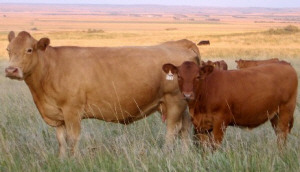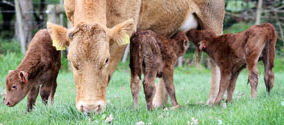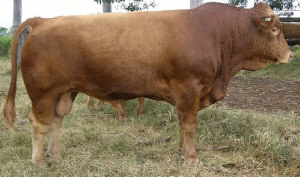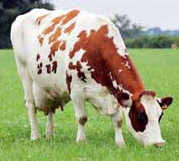



Gelbvieh
History
Gelbvieh (pronounced Gel-fee) originated in the three Franconian districts of Northern Bavaria, in southern Germany. It was once a triple purpose breed (milk, meat and draft) and was developed from several local strains of 'Red-Yellow Franconian' cattle; Gelbvieh translates from the German, literally, as 'yellow cattle'. Photo courtesy of Gustins Diamond D Gelbvieh, www.gustinsdiamondd.com |
In 1958, the German government imposed a stringent progeny testing programme on the breed in a deliberate strategy to improve performance in milk and meat production traits. They used AI extensively and applied objective measurement in selection for productivity, maternal characters, fertility and calving east, as well as carcase quality.
The breed was transported to North America via semen in the mid 1970's. As soon as it arrived in the USA it was immediately subjected to close scrutiny in the massive comparative breed experiments which were just then starting at the Meat Animal Research Center at Clay Center in Nebraska.
In the US, Gelbvieh have become a research driven breed; driven by the research findings at the Clay Center in Nebraska. The results of this research have been so noteworthy that 70% of cattle ranchers near Clay Center and South Eastern Nebraska, now run Gelbvieh cattle or cross-breeds in their herds.
In 1979 the breed was taken to Australia via Scotland by Jim Swanee and Greg Lithgow who used the semen over Hereford. From here the breed has increased in numbers and is now a well known breed.
Characteristics
The breed is reddish gold to russet or black in colour, with strong skin pigmentation and fine hair making them ideal in temperate to arid conditions. Medium to large in size, a long body with above average muscling and were originally horned but the majority are now polled.Purebred male calves are born with an average weight of 40kg, female average is 38kg, they are exceptionally fast when it comes to pre-weaning growth, comparable or better than Charolais. Gelbvieh are medium to late maturing by normal standards and are said to have good milk production. Gelbvieh are generally good performers but some care is advisable when selecting sires for cross breeding over maiden heifers from smaller breeds.
Gelbvieh are also known for their quiet disposition, docility.
Statistics
Gelbvieh have a quiet nature displaying a docile temperament. Gelbvieh pass this quality on to their offspring. A quiet nature is being demanded by producers and processors and has its roots in safety, bruising and the meat quality areas.
Gelbvieh have the earliest puberty of any beef breed (only dairy breed Jersey is earlier), so in normal cattle country, Gelbvieh can be joined at 13 months to calve at 22 months - instead of at 24 months with other breeds.
 Photo courtesy of Gelbvieh Cattle Breeders Society of New Zealand, www.gelbvieh.org.nz Rotomara Kareen 8yrs old with triplets sired by Back to Basics |
Nearly all European breeds are used as terminal sires. Gelbvieh can not only be used as terminal sires but their heifer progeny can most certainly be kept as breeding females as well. Their puberty, fertility and milk production is superiority over other European cross females. This has been established overseas with massive crossbreeding trials.
From studies carried out at the Clay Centre, Nebraska USA. Gelbvieh had the largest ribeye-muscle area per 100kg of all breeds. Hence they have high cutout yields.
Gelbvieh are a lean breed but given their fast growth rate and their marketability as yearlings, they are a potential source of high quality tender young beef. Gelbvieh can produce Champion carcases when crossed with British breeds. Gelbvieh bulls are and excellent choice to cross with Angus females for producing carcase winning steers.
Gelbvieh had the largest testicles of all breeds in the Clay Centre research and since testicular size is related to the fertility of their daughters, this probably explains why the females are most fertile and even precocious. Gelbvieh bulls taken to AI centres for semen collection have had the most verile semen counts and quality seen of any breed.
Originally Gelbvieh where bred for milk production as well as beef, they have exceptional udders and milking ability.
Gelbvieh produced the highest weaning weight per cow exposed to breeding at Clay Centre - which reflects their good performance in fertility, milk and growth. Weaning weights are usually more than 200kg at 7 months.
Usually above 300kg.
The South African Gelbvieh Association has reported a distinct tolerance to both heat and ticks and there have been confirmatory reports from Queensland. Gelbvieh bulls stand in the sun quite contentedly while British and most other European breeds seek the shade. When seed ticks bite Gelbvieh, the blood flow to the bite region is constricted so that the ticks are isolated and starve. These features of Gelbvieh are currently being researched.
Comparative
According to the USDA Meat Animal Research Centre Gelbvieh are the only widely used breed that excels in calving ease, milk yield, retail yield, weaning growth and yearling growth combined.Distribution
 Photo courtesy of Midas Gelbvieh, www.midasgelbvieh.com.au |
References (the above information was cited from the following sites)
www.ansi.okstate.edu
www.gustinsdiamondd.com
www.midasgelbvieh.com.au
www.gelbvieh.org.nz
www.gelbvieh.asn.au
gelbvieh.co.za


